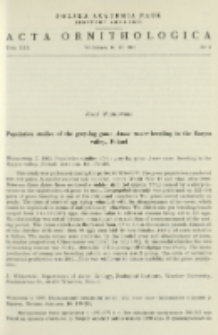- Search in all Repository
- Literature and maps
- Archeology
- Mills database
- Natural sciences
Advanced search
Advanced search
Advanced search
Advanced search
Advanced search

Object
Title: Population studies of the grey-lag goose Anser anser breeding in the Barycz valley, Poland
Subtitle:
Breeding of the grey-lag goose ; Badania nad populacją gęgawy Anser anser gnieżdżącej się w dolinie Baryczy, Polska
Contributor:
Polska Akademia Nauk. Instytut Zoologii
Publisher:
Place of publishing:
Description:
Type of object:
Abstract:
This study was performed during the period 1972 to 1977. The goose population numbered 280-312 pairs. A similar number was reported before World War II and then after 1960. Between these dates there occurred a sudden drop (of approx. 75%) caused by a sharp increase in the exploitation of geese by man. The population study was performed on 122-154 paire of goose breeding in one of the fish-pond complexes. The geese nested exclusively on ponds. The time of start of egg laying coincided with the disappearance of ice cover, which could be explained in terms of antipredatory behaviour. The clutch size per breeding female ranged from 2 to 10 (12?) eggs, the mean value in different seasons being 4.9 to 5.6 eggs. No relationship was noted between mean clutch size and time of commencement of the nesting period. The mean clutch size decreased from 6. 7 to 3.5 as the season passed. Almost all of the clutches with more than 10 eggs were laid by two females. 44.2 % of nests ended in a failure. The main causes were predation by the hooded crow and abandonment of nests, in similar proportions. Other causes accounted for only 0.9 %. In successful clutches the rate of hatching success was 90.4%. Mortality of the young (till fledging) was 27.4 %. The mean production of young per breeding pair in one season was 2 young. The ratio of actual to potential production was 38%. This was sufficient to ensure stability of the goose population.
Relation:
Volume:
Issue:
Start page:
End page:
Detailed Resource Type:
Format:
Resource Identifier:
Source:
MiIZ PAN, patrz sygn. czas. P.257, T. 19, Nr 8 ; MiIZ PAN, patrz sygn. czas. P.4568, T. 19, Nr 8 ; click here to follow the link
Language:
Rights:
Licencja Creative Commons Uznanie autorstwa 3.0 Polska
Terms of use:
Zasób chroniony prawem autorskim. [CC BY 3.0 PL] Korzystanie dozwolone zgodnie z licencją Creative Commons Uznanie autorstwa 3.0 Polska, której pełne postanowienia dostępne są pod adresem: ; -
Digitizing institution:
Muzeum i Instytut Zoologii Polskiej Akademii Nauk
Original in:
Biblioteka Muzeum i Instytutu Zoologii PAN
Projects co-financed by:
Access:
Object collections:
- Digital Repository of Scientific Institutes > Partners' collections > Museum and Institute of Zoology PAS > Scientific Journals
- Digital Repository of Scientific Institutes > Partners' collections > Museum and Institute of Zoology PAS > MIZ PAN Publications > Acta Ornithologica
- Digital Repository of Scientific Institutes > Literature > Journals/Articles
Last modified:
Oct 2, 2020
In our library since:
May 16, 2019
Number of object content downloads / hits:
286
All available object's versions:
https://rcin.org.pl./publication/38373
Show description in RDF format:
Show description in RDFa format:
Show description in OAI-PMH format:
Objects Similar
Gromadzki, Maciej (1940– ) Wieloch, Maria
Kalisińska, Elżbieta Wysocki, Rościsław Dańczak, Alicja Kalisiński, Marek M. Engel, Jacek
Engel, Jacek Majewski, Przemysław
Randler, Christoph
Lewartowski, Zenon Stawarczyk, Tadeusz (1952– ) Winiecki, Aleksander (1956– )
Górski, Wojciech (1946–2001) Górska, Ewa
Zając, Ryszard Zygmunt (1936– )

 INSTYTUT ARCHEOLOGII I ETNOLOGII POLSKIEJ AKADEMII NAUK
INSTYTUT ARCHEOLOGII I ETNOLOGII POLSKIEJ AKADEMII NAUK
 INSTYTUT BADAŃ LITERACKICH POLSKIEJ AKADEMII NAUK
INSTYTUT BADAŃ LITERACKICH POLSKIEJ AKADEMII NAUK
 INSTYTUT BADAWCZY LEŚNICTWA
INSTYTUT BADAWCZY LEŚNICTWA
 INSTYTUT BIOLOGII DOŚWIADCZALNEJ IM. MARCELEGO NENCKIEGO POLSKIEJ AKADEMII NAUK
INSTYTUT BIOLOGII DOŚWIADCZALNEJ IM. MARCELEGO NENCKIEGO POLSKIEJ AKADEMII NAUK
 INSTYTUT BIOLOGII SSAKÓW POLSKIEJ AKADEMII NAUK
INSTYTUT BIOLOGII SSAKÓW POLSKIEJ AKADEMII NAUK
 INSTYTUT CHEMII FIZYCZNEJ PAN
INSTYTUT CHEMII FIZYCZNEJ PAN
 INSTYTUT CHEMII ORGANICZNEJ PAN
INSTYTUT CHEMII ORGANICZNEJ PAN
 INSTYTUT FILOZOFII I SOCJOLOGII PAN
INSTYTUT FILOZOFII I SOCJOLOGII PAN
 INSTYTUT GEOGRAFII I PRZESTRZENNEGO ZAGOSPODAROWANIA PAN
INSTYTUT GEOGRAFII I PRZESTRZENNEGO ZAGOSPODAROWANIA PAN
 INSTYTUT HISTORII im. TADEUSZA MANTEUFFLA POLSKIEJ AKADEMII NAUK
INSTYTUT HISTORII im. TADEUSZA MANTEUFFLA POLSKIEJ AKADEMII NAUK
 INSTYTUT JĘZYKA POLSKIEGO POLSKIEJ AKADEMII NAUK
INSTYTUT JĘZYKA POLSKIEGO POLSKIEJ AKADEMII NAUK
 INSTYTUT MATEMATYCZNY PAN
INSTYTUT MATEMATYCZNY PAN
 INSTYTUT MEDYCYNY DOŚWIADCZALNEJ I KLINICZNEJ IM.MIROSŁAWA MOSSAKOWSKIEGO POLSKIEJ AKADEMII NAUK
INSTYTUT MEDYCYNY DOŚWIADCZALNEJ I KLINICZNEJ IM.MIROSŁAWA MOSSAKOWSKIEGO POLSKIEJ AKADEMII NAUK
 INSTYTUT PODSTAWOWYCH PROBLEMÓW TECHNIKI PAN
INSTYTUT PODSTAWOWYCH PROBLEMÓW TECHNIKI PAN
 INSTYTUT SLAWISTYKI PAN
INSTYTUT SLAWISTYKI PAN
 SIEĆ BADAWCZA ŁUKASIEWICZ - INSTYTUT TECHNOLOGII MATERIAŁÓW ELEKTRONICZNYCH
SIEĆ BADAWCZA ŁUKASIEWICZ - INSTYTUT TECHNOLOGII MATERIAŁÓW ELEKTRONICZNYCH
 MUZEUM I INSTYTUT ZOOLOGII POLSKIEJ AKADEMII NAUK
MUZEUM I INSTYTUT ZOOLOGII POLSKIEJ AKADEMII NAUK
 INSTYTUT BADAŃ SYSTEMOWYCH PAN
INSTYTUT BADAŃ SYSTEMOWYCH PAN
 INSTYTUT BOTANIKI IM. WŁADYSŁAWA SZAFERA POLSKIEJ AKADEMII NAUK
INSTYTUT BOTANIKI IM. WŁADYSŁAWA SZAFERA POLSKIEJ AKADEMII NAUK


































